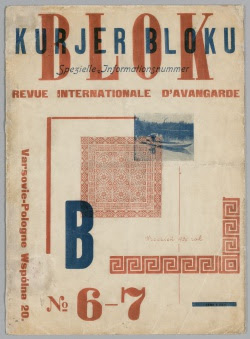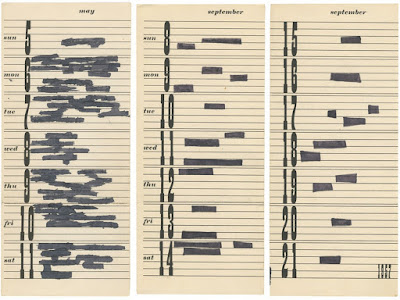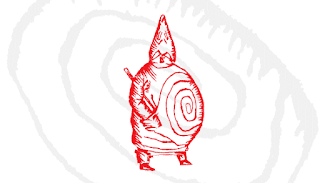This index lists avant-garde and modernist periodicals, first issues of which appeared between 1890 and 1939. Besides serving as an engine of discovery, it is also made to help following bibliographic references to sources. A couple of technical notes.. The 'Online' column lists freely accessible digitized versions of each magazine; the abbreviations used for digital libraries are listed in the section below. The first column points to the wiki pages with more information about titles which in many cases also contain versions mirrored on Monoskop. Some columns are sortable. Information is sourced from a number of repositories and reference websites. The list is far from being exhaustive [1] [2], preference is given to periodicals accessible online. As with all sections on Monoskop this page is a work in progress and contributions are welcome.
You can download it here :
http://monoskop.org/Avant-garde_and_modernist_magazines#Index
Sunday, January 31, 2016
Avant-garde and modernist magazines
Sunday, January 24, 2016
Barragán’s Ciudad del México
A
collection of unpublished drawings preserved by the Barragán
Foundation bear witness to Luis Barragán’s hopes and fears for the
future development of Mexico City. Text by Federica Zanco.
Paisaje de la Ciudad de Mexico
Juan
O‘Gorman, Paisaje
de la Ciudad de Mexico ,
1947–49, tempera/masonite, 66 x120
cm (Collection of the Museo de Arte Moderno, Mexico City)
Saturday, January 23, 2016
Obras de Plotino C. Rhodakanaty
Obras de Plotino C. Rhodakanaty. Edicion, Prolongo y notas de Carlo Illades, Recopilacion Maria Esther Reyes Duarte, UNAM, 1998
The Invention of “emotional architecture”
Extract
from Reina Sofía Museum brochure of the exhibition:
Emotional
Architecture: The Work as Strategy Mathias Goeritz (Danzig, now
Gdansk, 1915) was educated in the turbulent Berlin of the
inter-war period, in the midst of the rise of National
Socialism. During the Second World War and the subsequent Cold
War, Goeritz forged himself a multiple personality. He was first
a philosopher and historian and afterwards a painter, a
development which coincided with his period at the German
Consulate in the Spanish protectorate of Morocco. From 1945 to
1948, Goeritz was feverishly active in Spain as a cultural
promoter, and in 1949 he moved to Mexico, where he intensified
his dual activity as an artist and agitator. It was there that
he condensed his aesthetic principles under the notion of
emotional architecture, which he was to apply not only to the
construction of buildings but also to painting, sculpture, graphics
and visual poetry. At a moment when figurative art and propaganda
dominated the art scene in Mexico, emotional architecture became
a device for confrontation, yet was well received by the politically
more conservative architectural profession. The increased number
of construction projects at that time meant that the potential for
commissions was very great. The work manifesto of emotional
architecture is the El Eco Experimental Museum which defines his
later production. Here Goeritz gathers various media (painting,
sculpture, furniture design and architecture) and works by
artists like Germán Cueto, Henry Moore and Carlos Mérida, his
own contributions being a monumental visual poem and the
formidable transposable sculpture of a twisted geometric snake,
transforming the open courtyard into a performance environment.
In
Torres de Ciudad Satélite (Towers of Satellite City), the
artist tests the limits of scale, artwork-viewer proximity, and
even modes of viewing. Five reinforced cement prisms of colossal
size foster the affective mobilization of the viewer and the
aestheticization of the effect, turning the work into a national
emblem of modernity. From then on, the use of a monumental scale
and the synthetic language of geometries, associated with the
idea of progress, identified Goeritz’s work as strategist and
agitator. A constructor of spatialities where new relations and
senses could be established, his art of mediations shakes the
institutions that validate art, such as the museum and criticism
(El Eco), artistic groups and the gallery (the group of Los
Hartos), and history and believe systems (the snake and the
pyramid or the cross and the star of David). Approaching his
oeuvre obliges us to engage with a work implicated with
cultural agency. The interest aroused today by the aspects of
circulation and reception in relational, contextual and
participative art contrasts with the development of that
creative modality of artistic mediation, that aesthetic of
commotion with which Goeritz experimented until his death in
1990.
Tuesday, January 19, 2016
Mount the Air
Sunday, January 17, 2016
Πλωτίνος Ροδοκανάκης
Τέο
Ρόμβος, Πλωτίνος Ροδοκανάκης – Ένας
Έλληνας Αναρχικός, Βιογραφία, Ηλέκτρα,
Α΄ έκδοση 2005, Β΄ έκδοση 2008, σελ. 234
https://romvos.wordpress.com/βιβλία/plotinos-rodokanakis/Alfred Jarry Archipelago
De
Jarry on ne retient que le scandale d’Ubu
Roi
qui masque une œuvre complexe placée sous le signe de
l’expérimentation radicale et le mélange des genres. En
réunissant un ensemble exceptionnel d’artistes internationaux et
inclassables, « Alfred Jarry Archipelago » démontre que
tout un pan de l’art et de la performance actuels est traversé par
cette puissance de transgression "jarryesque".
Poète,
dramaturge et dessinateur, Alfred Jarry (1873-1907) pulvérise les
frontières de l’ordre social, moral et esthétique du XIX ème
siècle finissant. Retentissant comme un coup de tonnerre, le célèbre
"Merdre !" de son Ubu
Roi
ouvre la voie aux développements de la modernité à venir.
D’un
tournant de siècle à l’autre, l’œuvre et les idées de Jarry
semblent irriguer de nouveau la société et l’art contemporain.
Abolissant les limites (des disciplines, de l’identité, du bon
sens et du bon goût) tant dans sa vie que dans ses écrits, Jarry
inaugure une approche inédite de la théâtralité, du langage et du
corps pour explorer les rapports de domination, liés au pouvoir ou
au savoir. « Alfred Jarry Archipelago » se présente
comme une spéculation sur les résurgences de ces motifs dans les
arts visuels, à la lisière du politique, du théâtre et de la
littérature.
Dans
son célèbre Gestes et
Opinions du Docteur Faustroll,
pataphysicien, Alfred Jarry dédie chaque chapitre à un écrivain ou
un peintre de son temps. Convoquant la figure de Jarry comme
commissaire posthume, « Alfred Jarry Archipelago »
imagine quel paysage artistique composerait l’auteur aujourd’hui.
Autour d’une exposition collective et d’un festival à la Ferme
du Buisson, le projet se déploie dans d’autres lieux et d’autres
formats - et se conclura par une importante publication par les
différents partenaires.
William
Anastasi / Julien Bismuth / Paul Chan / Marvin Gaye Chetwynd / Rainer
Ganahl / Dora Garcia / Naotaka Hiro / Mike Kelley / Tala Madani /
Nathaniel Mellors / Henrik Olesen
Curators:
Keren Detton and Julie Pellegrin
October
18, 2015–February 14, 2016
Centre
d’art contemporain de la Ferme du Buisson
Allée
de la Ferme – Noisiel, Marne-la-Vallée
Labels:
exhibition,
modernities,
pataphysics,
theatre
Wednesday, January 13, 2016
Plebeian Council
Theaters of Democracy
In
October 1943, parliament met to debate the question of how the
heavily bomb-damaged Palace of Westminster should be restored. With
Winston Churchill's approval, they agreed to retain its adversarial
rectangular pattern instead of changing to a semi-circular or
horse-shoe design favoured by some legislative assemblies. Churchill
insisted that the shape of the old Chamber was responsible for the
two-party system, which is the essence of British parliamentary
democracy. It was at this debate that he famously noted: 'we shape
our buildings and afterwards our buildings shape us.'
Today
a parliamentary commission is once again considering options for the
urgent restoration of the Palace of Westminster. The scenarios
include a proposal that MP’s decamp from the building for the 11
years of a £3.5 billion building project. If they remain in place,
the project will be longer and costlier still.
At
this crucial moment in the Houses of Parliament’s history, the
Architecture Foundation is staging a special event at Westminster, at
which panellists will address the question of whether the
architecture of Pugin and Barry’s building remains fit for a
twenty-first century democracy. In particular, they will ask how the
imminent building works could enable a radical reinvention both of
parliament’s built form and its democratic procedures.
Speakers
include David Mulder and Max Cohen de Lara, of the Amsterdam-based
XML Architects, whose research into the architecture of the world’s
parliament buildings featured in the 2014 Venice Architecture
Biennale and is soon to be published in the book “Parliament”.
They will be joined by Pugin’s biographer, Rosemary Hill, who will
talk about the debates that led to the establishment of the Palace of
Westminster in its present form and by Michael Deacon, the
parliamentary sketchwriter of The Daily Telegraph, who will offer an
insider’s view of the building’s successes and failures.
26
January
Attlee
Suite, Portcullis
House, London
Sunday, January 3, 2016
Ordre de la Grande Gidouille -Nomination de Boris Vian
Nomination de Boris Vian comme Promoteur Insigne de l'Ordre de la Grande Gidouille , le 22 Palotin 80 (11 mai 1953)
One day of Lectures of Hilde Goes Ager
Talk
08.01.16
1.
Asger Jorn – Thinking in Threes’, introduction into the
thinking/writing of the Danish experimental artist Asger Jorn by
Hilde de Bruijn.
2.
Alfred Jarry and Asger Jorn: The Epicurean Influence as Social
“Swerve” by Kostis Velonis
3.
What Asger Jorn help me [un]learn.” Theses concerning the movements
and modes of the artist in the symmetrified world of economics by
Yannis Isidorou
Asger
Jorn – Thinking in Threes’, introduction into the
thinking/writing of the Danish experimental artist Asger Jorn by
Hilde de Bruijn.
The
lecture starts out with a description of some of his work. This part
of the presentation serves to both contextualize Jorn in his own time
frame, and to introduce many of the key elements in his way of
thinking as his artistic output was always developed in direct
dialogue with his theoretical point of view. In the second part of
the lecture I will discuss the triolectic thinking method that Jorn
developed.
Hilde
de Bruijn is a curator in contemporary and modern art based in
Amsterdam. She studied Art History at the Radboud University,
Nijmegen, and took the Curatorial Training Programme at De Appel,
Amsterdam (2000/2001). She was Head of Exhibitions of former SMART
Projects Space, Amsterdam (2007-2010). She is currently a curator at
the Cobra Museum of Modern Art, Amstelveen (NL) where she creates
dialogues between the museum’ collection and contemporary
art(ists).
As
a freelance curator her main activity a curatorial research into the
writings of the Danish artist and thinker Asger Jorn together with
contemporary artists and art historians. The research is reflected in
the blog www.hildegoesasger.org.
Within this framework public events took place at various venues Or
Gallery, Berlin (2015); The Statens Museum, Copenhagen (2014); Nieuwe
Vide, Haarlem (2014); Officin – Books, Papers and Prints,
Copenhagen (2014); Casco, Office for Art, Design and Theory, Utrecht
(2014); AGORA, 4th Athens Biennial (2013).
Recent
publications: ‘Cobra and the Contemporary’, in: CoBrA. Una grande
avanguardia europea (1948-1951), Skira Edditore, Rome, 2015; ‘Asger
Jorn: The Secret of Art, in: Bocchicchio Luca and Valenti Paola
(eds), Asger Jorn. Oltre la forma, Genova University Press, 2015;
‘From a Calculated Forgetting to the Reality of the Archive’ in:
Tsivopoulos, Stefanos and De Bruijn, Hilde (eds), Stefanos
Tsivopoulos: ARCHIVE CRISIS, Shaking up the Shelves of History: A
Visual Essay on Media Images from the Recent Political Past of
Greece, Jap Sam Books, 2015.
Alfred
Jarry and Asger Jorn: The Epicurean Influence as Social “Swerve”
by Kostis Velonis
I
am trying to answer the question whether the swerve (κλιναμεν)
in the way that Lucretius defines it, involving the deviation of
atoms in the field of physics, contributes to a theory of free will.
If so, it can be operated by implication to the terms of a theatrical
(Alfred Jarry) and pictorial avant garde (Asger Jorn), and even
through clear morphological facts?
Μovements
that deviate from their expected precise recurrence, thus defining
what we call contingency, constitute Alfred Jarry’s way of
philosophizing, through Dr. Faustroll, as well as his nihilistic
caricaturizing, through the cowardly and greedy King Ubu.
Respectively, Asger Jorn’s commitment to ‘primitivism’ and also
his theoretical contribution to the practice of arabesque seeks
answers beyond the “experimental” context of his Zeitgeist. Both
of them, through the parody of physics (pataphysics) make use of the
deviant course (declinatio) which is the structural substance of
freedom.
Kostis
Velonis lives and works in Athens. He holds an MRes in Humanities and
Cultural Studies from London Consortium (Birkbeck College, ICA, AA,
Tate). He studied Arts Plastiques/ Esthétiques at Université Paris
8 (D.E.A). He earned his PhD from the Department of Architecture,
N.T.U.A University of Athens. He taught on the subject of domesticity
in relation to the avant garde movements as a Lecturer at the School
of Architecture of the University of Thessaly (2008-2011).
Selected
solo/group shows include (2015-2014): 2015: “Mount the Air”,
Kalfayan Galleries, Athens, “This probably will not work”,
Lothringer 13-Städtische Kunsthalle München, Μunich; “Super
superstudio”, PAC, Milan; “Adventures of the Black Square:
Abstract Art and Society 1915 –2015”, Whitechapel Gallery,
London; “Au nom de le Corbusier”, Maison Spiteris, Athens, “Rims
and Frontiers” Delphi Archaeological Museum, 2014: “ The Theater
of the World”, Museo Tamayo, Mexico City; “This is Not My
Beautiful House”, Kunsthalle Athena, “No Country for Young Men”,
BOZAR, Brussels; “Direct Democracy” , MUMA, Melbourne , “The
Future Lies Behind Us”, AD Gallery, Athens, “Tout Feu Tout
Flamme”, Lefebvre & Fils, Paris
Forthcoming
solo show: Casa Maauad, Mexico City, Mexico, 2016 (artist in
residence).
What
Asger Jorn help me [un]learn.” Theses concerning the movements and
modes of the artist in the symmetrified world of economics by Yannis
Isidorou
Yiannis
Isidorou was born in Piraeus and he lives and works in Athens. In
most of his work and practices as an artist, he is seeking a coherent
commentary on the human potential for interpreting the world, and at
the same time a critical investigation on the utopia for the world’s
change, and the consequent dystopian realizations of these changes.
He
is co-founder and editor of the Greek e-magazine happyfew.gr /
danger.few, on politics, philosophy and art. Ηe was a founding
member of intothepill, an artists’ collective with diverse
activities and participations in international art projects and
exhibitions. Since 2009 he works with artist Yiannis Grigoriadis
through Salon de Vortex, an artistic co-operation for experiments and
affiliations between artists, writers, theorists, technicians,
workers, scientists and anyone else who can contribute to a thorough
research on democracy, dominance and decay in the late capitalist
European society. Since 2013 he is the artistic director of [ΦΡΜΚ],
the biannual journal in print, on poetry poetics and visual arts.
Supported
by DAAD Programme: Partnerships with Greek Institutions of Higher
Education 2014 – 2016 / A Cooperation between the Academy of Fine
Art Munich (ADBK) and the Athens School of Fine Arts (ASFA)
One
day of lectures and Q&A in the framework of HILDE GOES AGER, a
curatorial research into the thinking and writing of the experimental
artist Asger Jorn (1914-1973).
Labels:
art theory,
Cartographies and Diagrams,
Internationale situationniste,
modernities,
pataphysics,
Phynance,
Puppet Theatre,
Symposium and Conversations,
theatre,
Theory for Design
Subscribe to:
Comments (Atom)








